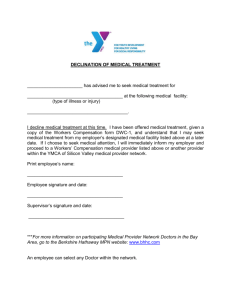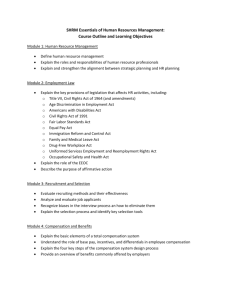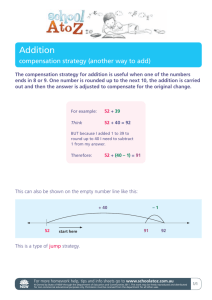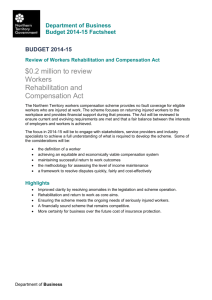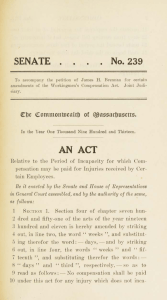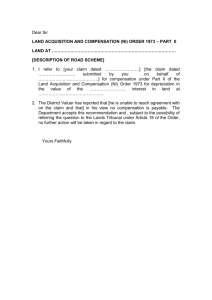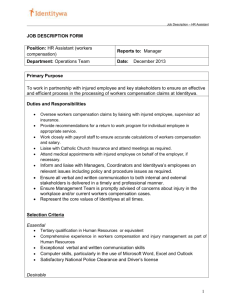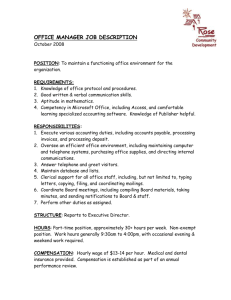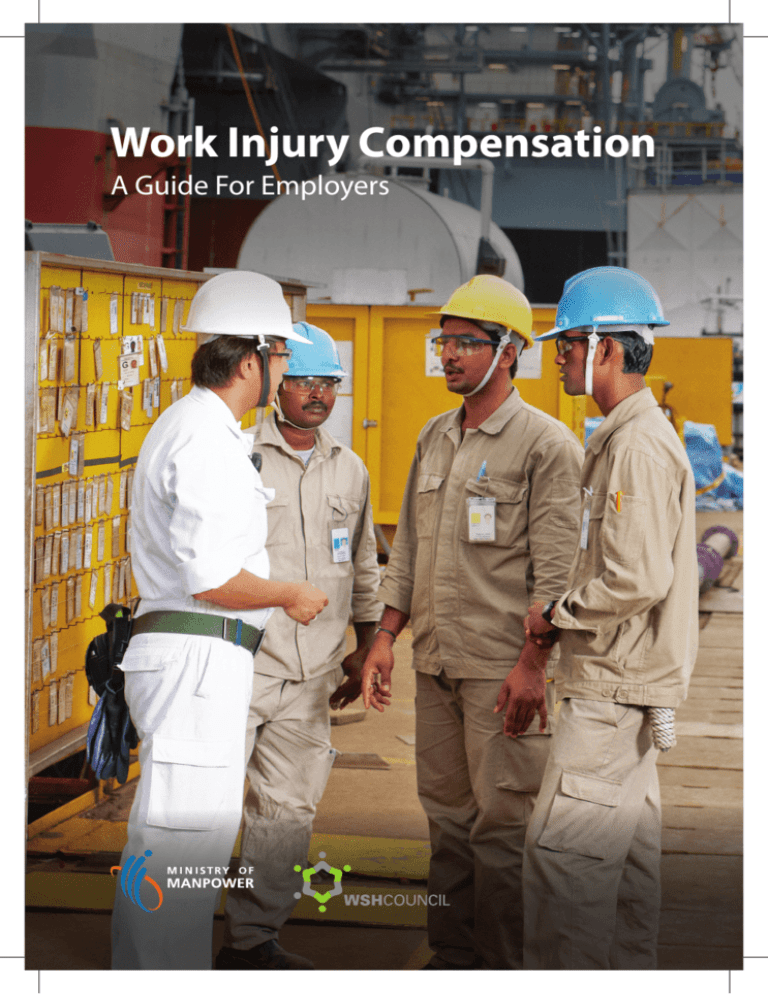
Work Injury Compensation
A Guide For Employers
Foreword
This guide provides a brief overview of the Work Injury Compensation Act
and the procedures for making claims. It also outlines the amendments to
the Act that were passed by Parliament in November 2011. These changes
) will take effect on 1 June 2012.
(highlighted as
The information contained in this guide is provided for information only,
and does not constitute legal advice. In cases of doubt, reference should
be made to the Work Injury Compensation Act.
Contents
Overview of Work Injury Compensation Act (WICA)
i. What is the Work Injury Compensation Act
3
ii. Who is covered under WICA
4
iii. When is compensation payable
4
iv. What benefits can be claimed under WICA
6
Work Injury Compensation (WIC) Insurance
i. Is it mandatory to purchase Work Injury Compensation insurance
9
9
ii. Changes related to WIC insurance
iii. Guide to purchasing WIC insurance
10
iv. Providing details of WIC insurance to MOM
11
The Work Injury Compensation Claim Process
i. What you should do as an employer
13
ii. Checking status of claim
17
Incident Reporting
i. Requirement to report incidents
19
ii. How to report: Notify the Commissioner
20
iii. How to report: Submit an Incident Report
21
2
Overview of
Work Injury
Compensation Act
What is the Work Injury Compensation Act?
The Work Injury Compensation Act (WICA) provides injured employees with a low-cost
and expeditious alternative to common law to settle compensation claims.
To claim under WICA, the employee only needs to prove that he was injured in a work
accident or suffered a disease due to his work. Engaging a lawyer is not required. His
employer (or employer’s insurer) is liable to pay the compensation regardless of who
caused the accident/disease, and even after the employment has ceased or the Work
Pass (of a foreign worker) has been cancelled. The amount of compensation is computed
based on a fixed formula and is subject to caps. Dependants of deceased employees are
also eligible to claim Work Injury Compensation.
Alternatively, the employee can file a civil suit against the negligent party under common
law for damages. However, to succeed, he and his lawyer will need to prove that the
employer or a third party had caused his injury. He will also need to substantiate the
amount of damages before the Courts, and damages are not capped.
An injured employee can claim from either WICA or common law, but not from both.
Refer to pages 6 and 7 to find out more on the compensation formula and limits.
3
Who is covered under WICA?
Covered
Not covered
All employees engaged
under a “contract of
service” or “contract of
apprenticeship” with an
employer, regardless of
salary level.
Self-employed persons / independent contractors
Domestic workers
Any member of Singapore Armed Forces and
any uniformed officers of Singapore Police Force,
Singapore Civil Defence Force, Central Narcotics
Bureau or the Singapore Prisons Service
What is “contract of service”?
A contract of service is any agreement, written or oral, where one person agrees to
employ another as an employee.
When is Compensation Payable?
Compensation is payable when an employee:
• suffered an injury by an accident arising out of and in the course of employment, or
• contracted an occupational disease, or
•
contracted a disease due to work-related exposure to biological or
chemical agents
What is considered “an accident arising out of and in the course of employment”?
It refers to an accident that (i) happened during working hours/overtime or while
on official duties (“in the course of employment”) and (ii) happened due to work
(“out of employment”).
E.g. A wood factory worker makes use of his free time during working hours to build
himself a cupboard. He hurt his finger while doing so. Although the accident happened in
the course of his employment (occurred during working hours), it did not arise out of his
employment as it was not due to work. Thus, the accident is not compensable under WICA.
It includes incidents that are incidental to employment such as while going to the toilet
as well as slipping and falling within company’s premise.
An accident that happened in the course of employment is regarded as having arising
out of the employment unless there is evidence to prove otherwise.
Refer to Annex A on page 22 for the list of occupational diseases
that are compensable under WICA.
4
Overview of the Work Injury Compensation Act (WICA)
See table below on wica’s coverage for some commonly misunderstood scenarios.
Scenario
Compensable
under WICA?
Employee met with a traffic accident while taking company
transport to and fro between home and workplace. The vehicle
is not a public transport.
Yes
Employee met with a traffic accident while travelling in his own
car / his friend’s car / public transport to and fro between home
and workplace.
No
(a) Employee did not make
any personal detour such as
running personal errand.
Yes
(b) Employee met with
an accident while making
a personal detour.
No
Employee, who is employed by a Singapore employer and resides in
Singapore during his course of employment, suffered a work injury
during an overseas assignment.
Yes
Seaman suffered a work injury while on board a Singapore-registered
vessel, regardless of the location of the vessel.
Yes
Employee’s injury was due to him being under influence of alcohol
or a prescription drug which was not prescribed by a doctor.
No
Deliberate self-injury or deliberately making the injury worse.
No
Commuting accidents during work
and for work purpose (e.g. travel from
workplace to venue for meeting),
regardless of the mode of transport.
Workers who are injured in work-related fights are not eligible for compensation, except
in certain scenarios such as when the worker was a victim and did not participate in the
fight, or when he was injured while exercising private defence, or instructed to break up
the fight, safeguard life/property or maintain law and order.
5
What benefits can be claimed under WICA?
Three compensation benefits can be claimed:
•
•
•
Medical leave wages
Medical expenses
Lump sum compensation for permanent incapacity or death
Medical Leave Wages
Outpatient medical leave (MC)
Hospitalisation leave
Full pay
Up to 14 days
Up to 60 days
2/3 pay
15th day onwards,
up to 1 year from accident
61st day onwards,
up to 1 year from accident
Things to note about medical leave wages:
1. Computed based on worker’s Average Monthly Earnings (AME) i.e. average earnings
over last 12 months before the accident, including overtime pay, but excluding
transport allowance and reimbursement.
2. Payable only for working days that are covered by doctor-granted MC/hospitalisation
leave.
3. No medical leave wages payable on non-working days e.g. rest day and public
holiday.
4. Employers are required to make payment no later than the worker’s usual pay day.
Medical Expenses
•
Payable by employer, up to maximum limits (see table below), as long as
treatment is considered necessary by a Singapore-registered doctor.
•
Medical expenses include cost of medical consultation fees, ward charges,
treatment, charges for physiotherapy, occupational and speech therapy,
the cost of medicines, artificial limbs and surgical appliances, etc.
Maximum Limits
6
For accidents that happened
before 1 Jun 2012
For accidents that happened on and
after 1 Jun 2012
Up to $25,000 or 1 year from
date of accident, whichever
is reached first
Up to $30,000 or 1 year from date of
accident, whichever is reached first
Overview of the Work Injury Compensation Act (WICA)
Compensation for Permanent Incapacity and Death
Permanent Incapacity
Compensation
Death Compensation
When is it
payable?
When injury or illness has
permanent effects on the
employee’s ability to work
When injury caused death
of employee
Formula for
computing
compensation
Amount payable = [employee’s
Average Monthly Earnings]1 x
[age multiplying factor]2 x
[% permanent incapacity]3
Amount payable = [employee’s
Average Monthly Earnings]1
x [age multiplying factor]2
Compensation
is payable to
Injured employee
Dependants of deceased
employee
Amount is
subjected to
the below
limits:
For accidents
that happened
before 1 Jun
2012
For accidents
that happened
before 1 Jun
2012
Minimum
$60,000 x
% PI
$73,000 x
% PI
$47,000
$57,000
Maximum4
$180,000 x
% PI
$218,000 x
% PI
$140,000
$170,000
For accidents
that happened
on and after
1 Jun 2012
For accidents
that happened
on and after
1 Jun 2012
Notes:
1
Refer to page 6 on the calculation of Average Monthly Earnings.
2
Refer to page 26 (Annex B) for the list of age multiplying factors.
3
% Permanent Incapacity (%PI) is based on doctor’s assessment after the employee’s medical
condition stabilises. Doctor makes the assessment based on a set of guidelines in the “Guide to the
Assessment of Traumatic Injuries and Occupational Diseases for Workmen’s Compensation”
(“GATIOD”) which is available at http://www.mom.gov.sg
4
An additional 25% of the compensation amount is awarded if an injured employee suffered total
permanent incapacity (i.e. 100% PI).
Refer to Annex C on page 28 for the calculation of the compensation amount
7
8
Work Injury
Compensation
Insurance
Is it mandatory to purchase Work Injury Compensation insurance?
Every employer is required by law to maintain adequate Work Injury Compensation (WIC)
insurance for:
• All employees doing manual work, regardless of salary level; and
• All employees doing non-manual work and earning $1,600 or less a month.
This is applicable to both local and foreign employees.
Failure to do so is an offence punishable by a maximum fine of $10,000 and/or
imprisonment of up to 12 months. If you did not maintain adequate insurance
(e.g. you have 10 manual workers but bought insurance for only 8 of them),
you would have committed an offence.
For other employees doing non-manual work with monthly earning of above $1,600,
employers have the flexibility to decide whether to buy insurance for them. In the event
of a valid claim, the employer will be required to pay the compensation if he does not
have insurance coverage for this group of employees.
Changes related to WIC insurance
1. Work-related exclusion clauses disallowed
Work-related exclusion clauses, except pertaining to asbestos, will be prohibited
for the purpose of WIC insurance. Insurers will be liable to make payment of the
compensation even if work-related exclusions exist in the policy. Insurers will
continue to be able to seek recovery contractually from the employer if such
recovery is included in the insurance policy. This is applicable to both local and
foreign employees.
2. Employer’s insurer liable to pay when there are multiple insurance policies
When there are multiple WIC insurance policies in place (e.g. main contractor’s project
insurance and sub-contractor’s annual policy), the employer’s insurance policy will
first be used to satisfy a claim. This helps ensure timely receipt of compensation by
the injured employee. A third party’s insurance policy can be allowed to pay the
compensation if they convey in writing to MOM its intent to pay compensation
on behalf of the employer’s insurer, before the notice of assessment is issued.
9
Guide to purchasing WIC insurance
When purchasing or reviewing insurance coverage, employers should
10
•
Ensure that there is a Work Injury Compensation insurance covering
their employees.
Such an insurance policy should cover the benefits stipulated under WICA for
employees injured at work, including medical leave wages, medical expenses
(both hospitalization and outpatient) and permanent incapacity & death
compensation.
•
Check the types of employees covered under the policy
Employers should review the occupations and number of employees listed on
the insurance policy. It must reflect the employees who should be covered.
Do not under declare the number of employees to be insured to the insurer.
This will cause some of your employees to be uninsured.
•
Check for any work-related exclusion clauses and recovery clauses
With effect from 1 June 2012, work-related exclusion clauses will be disallowed.
If an insurance policy bought after this date and contains work-related exclusion
clauses, the insurer will still be liable to pay the compensation in the event of
a valid claim. The insurer may be able to recover from the employer any such
compensation paid out if the insurance policy contains a contractual clause
allowing the recovery. When in doubt, employers should approach their insurers
to clarify on any of the terms in the insurance policy.
Work Injury Compensation (WIC) Insurance
Providing details of WIC insurance to MOM
(applicable for employers of Work Permit & S Pass employees only)
Employers are required to provide the following information to the Ministry
during issuance or renewal of the Work Permit or S Pass:
•
•
•
•
Name of Insurer;
Policy Number;
Policy Commencement Date; and
Policy Expiry Date (inclusive of maintenance period, if any)
Note: Expired polices will not be accepted.
11
12
The Work Injury
Compensation
Claim Process
What you should do when your employee suffers an injury or disease
due to work…
Step 1: Report Accident
•
Submit accident report to MOM
If your worker reports of being unwell, ask and find out if it is due to an accident or
a disease due to work. If so, submit a report via http://www.mom.gov.sg/ireport
within 10 days from the date of accident or date of diagnosis of the disease, or within
10 days from the 4th day of medical leave whichever applicable.
For cases involving less than 4 days of MC, you are encouraged to report the
accident or occupational disease to MOM if the employee wants to claim permanent
incapacity compensation under WICA.
•
Inform your insurer of the accident
This facilitates you getting reimbursements from your insurer.
•
Pay medical leave wages to the employee not later than his usual pay day
You are required to do so as long as the MC is issued by a Singapore doctor,
even if it is not from your company clinic.
•
Pay the medical expenses directly to the hospital / clinic
You are required to do so as long as the treatment is considered necessary by
a Singapore doctor, even if it is not provided by your company clinic.
Important:
1) Employee remains eligible to claim compensation even if his employment
or work pass has been terminated.
2) If employer has bought WIC insurance and is awaiting insurer to settle payment,
he is required to nonetheless pay the medical leave wages and medical
expenses to the employee promptly, and then obtain reimbursement from
the insurer later.
13
If you are the employer of a Work Permit holder…
•
Under the Employment of Foreign Manpower Act and conditions of the
Security Bond, you are required to upkeep and maintain the worker during
his stay in Singapore. This includes provision of medical treatment and acceptable
housing. Failure to do so may result in having your security bond forfeited.
•
Do not repatriate the worker against his wish if his WICA claim is outstanding.
Refer to pages 19 to 21 to find out more about incidents that need to be reported.
Steps 2 to 5 are only applicable should your employee (or his dependants) wish to
claim compensation for permanent incapacity or death.
Step 2: File Claim by Worker
14
For Permanent
Incapacity
Compensation
claims
For Death
Compensation
claims
•
MOM will send you a copy of the medical report form.
3
7
•
Once your employee decides to claim under
WICA, you are required to send the medical
report form and pay the medical report fees
to the treating hospital/clinic. This is for the
hospital/clinic to assess the extent of the
employee’s injury.
3
7
•
The medical report fee should be borne
by you.
3
7
•
You, the supervisor or/and co-workers may be
required to attend an interview with MOM
before MOM assesses whether the claim is
compensable.
3
3
The Work Injury Compensation Claim Process
Step 3: Worker undergoes medical assessment
•
Facilitate your employee to attend all his
medical appointments. This ensures his
early recovery and the speedy conclusion
of his claim.
For Permanent
Incapacity
Compensation
claims
For Death
Compensation
claims
3
7
Step 4: Receipt of Notice of Assessment
Majority of claims are settled within 3-6 months. For workers with more
complicated injuries, more time may be needed for their injuries to
stabilise before the doctor can assess the % permanent incapacity.
What to expect
•
Upon receipt of the medical report (or death certificate for fatal cases) from
the hospital/clinic, MOM will assess the compensation amount.
•
MOM will issue a Notice of Assessment to inform the employee, employer
and the insurer of the amount of compensation payable.
•
If anyone disagrees with the assessment, he has up to 14 days from the date
of the Notice of Assessment to lodge an objection with MOM. Any objection
lodged after this period may be disregarded.
•
Any party who is unclear on the content of the Notice should contact the
case officer for help immediately.
•
If no one objects to the Notice, employer/insurer is required to pay the
compensation within 21 days of the Notice. Please note that interest
may be incurred for late payment.
• If there is an objection(s), MOM will facilitate its resolution (See step 5).
15
Step 5: Resolve objections (if any)
Majority of disputes are resolved within 2-4 months. Disputes that are
required to be heard before the Labour Court will take more time.
Dispute Resolution
Type of Objections
What to Expect
•
•
The worker will undergo a re-assessment
with a panel appointed by the Work
Injury Compensation Medical Board.
•
The panel comprises 2 senior consultants
from restructured hospitals.
•
The Medical Board fee of $357 and any
other necessary tests required by the
Medical Board will be borne by the
objecting party. If the fee is not paid in
time, the objection may be struck off.
•
Award by the Medical Board is final.
This is regardless of whether the award
is higher, lower or same as the initial % PI
indicated in the Notice of Assessment.
•
MOM will hold a pre-hearing conference.
The objecting party will be required to
furnish supporting document or evidence
to substantiate his/her objection.
•
Unsubstantiated objection may be
struck off.
•
If dispute remains unresolved, the case
will be referred to the Labour Court
for hearing.
•
A party objects to the %
permanent incapacity (PI)
assessment given by the
assessing doctor.
Any other objections, such as the
injury/disease being work-related
or not, and the Average Monthly
Earnings indicated in the Notice
of Assessment being incorrect.
Once all disputes are resolved, MOM will issue a Court Order requiring the employer/
insurer to pay the compensation within 21 days of the Court Order. If payment is not
made, the claimant should seek help from MOM.
Important: Failure to pay compensation is an offence, punishable by a maximum
fine of $10,000 and/or imprisonment of up to 12 months.
16
The Work Injury Compensation Claim Process
Checking Status of Claim
To check the latest updates of a claim, you can:
•
•
•
•
Call MOM at 6438 5122 and follow the instructions on the interactive voice
recording system
Check the claim status online using the e-Service “Check Status of Work Injury Claim”
at http://www.mom.gov.sg
Contact the case officer handling the claim, or
Come to MOM personally and speak with an officer at the counters
17
18
Incident
Reporting
Requirement to report incidents
As an employer, you are required under the Workplace Safety and Health Act & Work
Injury Compensation Act to report an incident to MOM under the following scenarios:
Scenario
Reporting method
•
An employee died
in a work accident.
1. Notify the Commissioner at once and
•
An employee was injured in a
work accident or contracted a
disease due to work exposure to
biological / chemical agent, and
–Hospitalized for at least
24 hours, or
1. Submit incident report online within 10
calendar days of accident, receipt of the
written diagnosis for disease or within
10 days from the 4th day of medical leave
whichever applicable.
–Given MC for more than
3 calendar days (consecutive or
otherwise)
•
An employee contracted
an Occupational Disease.
2. Submit incident report online within
10 calendar days of accident.
2. If the employee subsequently died
from injury/disease, you must notify
the Commissioner as soon as you
know of the death.
Submit incident report online within
10 calendar days of receiving the
written diagnosis of the disease.
Refer to Annex D on pages 29 to 31 to know what kinds of incidents are required
to be reported. When in doubt, you are encouraged to report the incident.
19
How to report: Notify the Commissioner
Notify the Commissioner immediately if...
Who should report
•
An employee died
Employer
– during work or
– at a workplace as a result of work
•
Self-employed or member of public died at your workplace
as a result of works done
Occupier
•
Self-employed or member of public died or was injured as
a result of works done at your workplace and was sent to
hospital for treatment
Occupier
•
No one was injured but incident is considered a Dangerous
Occurrence (DO)
Occupier
•
•
Call +65 6317 1111 or
Fax to +65 6535 2550
You will be asked to provide the following information:
1.
2.
3.
4.
5.
6.
20
Date and time of the incident
Place of the incident
Name and identification number of the injured/deceased, if any
Name of the employer and occupier
Brief description of the incident
Name and contact details of the person making the notification
Incident Reporting
How to report: Submit an Incident Report
All incident reports are to be submitted online at http://www.mom.gov.sg/ireport within
10 days from the date of accident or date of diagnosis of the occupational disease, or
within 10 days from the 4th day of medical leave, whichever applicable.
You will need to have ready the following:
1. Personal particulars and company details of person reporting
2. Details of Incident/Occupational Disease
3. Details of injured person (e.g. personal particulars, employment, injury, insurance).
If you have not submitted the report within the mandated timeline, please:
•
•
submit the report without further delay and
include an explanation for your late reporting
You are required to update the online report when the injured is given more MCs.
21
Annex A: List of Compensable Occupational Diseases
22
S/N
Description of Occupational
Disease or Injury
Nature of Occupation
1
Anthrax
Any occupation involving exposure to animals
infected with the Anthrax spores or bacteria,
tissues or products of infected animals, or any
material or substance containing the Anthrax
spores or bacteria.
2
Asbestosis
Any occupation involving exposure
to asbestos fibre.
3
Barotrauma
Any occupation involving exposure
to compressed air.
4
Byssinosis
Any occupation involving exposure
to raw cotton fibre.
5
Cataract due to infra-red,
ultraviolet or X-ray radiation
Any occupation involving frequent
or prolonged exposure to infra-red,
ultraviolet or X-ray radiation.
6
Compressed Air Illness or its
sequelae, including dysbaric
osteonecrosis
Any occupation involving exposure
to compressed air.
7
Diseases caused by ionising
radiation
Any occupation involving exposure
to ionising particles from radioisotopes
or irradiation apparatus.
8
Diseases caused
by excessive heat
Any occupation involving exposure
to excessive heat.
9
Glanders
Any occupation involving exposure
to animals infected with the Burkholderia
mallei bacterium, tissues of infected animals,
or any material or substance containing the
Burkholderia mallei bacterium.
10
Leptospirosis or its sequelae
Any occupation involving exposure to animals
infected or environment contaminated with
the Leptospira bacteria, or any material or
substance containing the Leptospira bacteria.
Annexes
Annex A: List of Compensable Occupational Diseases (Cont’d)
S/N
Description of Occupational
Disease or Injury
Nature of Occupation
11
Liver Angiosarcoma
Any occupation involving exposure
to vinyl chloride monomer or arsenic.
12
Mesothelioma Any occupation involving exposure
to asbestos fibre.
13
Musculoskeletal disorders
of the upper limb
Any occupation involving exposure to
occupational risk factors involving repetitive
motion, forceful exertion, awkward postures
or vibration, affecting the upper limbs.
14
Noise-Induced Deafness
Any occupation involving prolonged
exposure to excessive noise.
15
Occupational Asthma
Any occupation involving exposure to any
chemical or other agent which is known to
irritate or sensitise the respiratory system.
16
Occupational skin cancers
Any occupation involving exposure to
polycyclic hydrocarbons, tar, pitch, bitumen,
mineral oil (including paraffin), soot or
arsenicals, or any compound, product,
or residue of any of these substances,
or to ultraviolet radiation.
17
Occupational skin diseases
Any occupation involving exposure to any
skin irritant or sensitiser or any other agent
which is known to damage skin.
18
Poisoning by —
Any occupation involving exposure to —
(a) Arsenic
Arsenic or any of its compounds, or any
mixture or solution containing arsenic
or any of its compounds;
(b) Benzene or a homologue of benzene
Benzene or any of its homologues, or any
mixture or solution containing benzene
or any of its homologues;
23
Annex A: List of Compensable Occupational Diseases (Cont’d)
S/N
24
Description of Occupational
Disease or Injury
Nature of Occupation
(c) Cadmium
Cadmium or any of its compounds, or any
mixture or solution containing cadmium
or any of its compounds;
(d) Carbamates
Carbamate, or any mixture or solution
containing any carbamate;
(e) Carbon disulphide
Carbon disulphide or any of its compounds,
or any mixture or solution containing carbon
disulphide or any of its compounds;
(f ) Carbon dioxide gas
Excessive levels of carbon dioxide;
(g) Carbon monoxide gas
Excessive levels of carbon monoxide;
(h) Cyanide
Cyanide, or any mixture or solution
containing any cyanide;
(i) Halogen derivatives of
hydrocarbon compounds
Any halogen derivative of hydrocarbon
compounds or any mixture or solution
containing any halogen derivative of
hydrocarbon compounds;
(j) Hydrogen sulphide
Hydrogen sulphide;
(k) Lead
Lead, or any of its compounds, or any mixture
or solution containing lead or any of its
compounds;
(l) Manganese
Manganese or any of its compounds, or any
mixture or solution containing manganese
or any of its compounds;
(m)Mercury
Mercury or any of its compounds, or any
mixture or solution containing mercury
or any of its compounds;
(n) Oxides of nitrogen
Excessive levels of oxides of nitrogen;
(o) Organophosphates
Organophosphates;
Annexes
Annex A: List of Compensable Occupational Diseases (Cont’d)
S/N
Description of Occupational
Disease or Injury
Nature of Occupation
(p) Phosphorus
Phosphorus or any of its compounds, or any
mixture or solution containing phosphorus.
19
Silicosis
Any occupation involving exposure
to silica dust.
20
Toxic hepatitis
Any process involving exposure to
tetrachloroethane, nitro-derivatives
or amino-derivatives of benzene
or vinyl chloride monomer.
21
Tuberculosis
Any occupation involving —
(a) close and frequent contact with a source
of tuberculosis infection, e.g. in the
medical treatment or nursing of a person
or persons suffering from tuberculosis,
or in a service ancillary to such treatment
or nursing; or
(b) exposure to any material which is
a source of tuberculosis infection,
e.g. in a laboratory.
22
Ulceration of the corneal
surface of the eye
Any occupation involving exposure to
tar, pitch, bitumen, mineral oil (including
paraffin), soot or any compound, product,
or residue of any of these substances.
25
Annex B: Table of Age Multiplying Factor
26
Age of
employee at
next birthday
after the
accident
Permanent
Incapacity
Death
Age of
employee at
next birthday
after the
accident
Permanent
Incapacity
Death
14
181
136
28
167
125
15
180
135
29
165
124
16
179
135
30
164
123
17
178
134
31
162
122
18
178
134
32
160
121
19
177
133
33
159
120
20
176
132
34
157
118
21
175
132
35
155
117
22
174
131
36
153
115
23
173
130
37
151
114
24
172
129
38
149
112
25
170
128
39
146
110
26
169
127
40
144
108
27
168
127
41
142
107
Annexes
Annex B: Table of Age Multiplying Factor (Cont’d)
Age of
employee at
next birthday
after the
accident
Permanent
Incapacity
Death
Age of
employee at
next birthday
after the
accident
Permanent
Incapacity
Death
42
140
106
55
114
86
43
138
105
56
111
84
44
136
104
57
108
82
45
134
103
58
105
80
46
132
102
59
102
78
47
130
101
60
99
75
48
128
100
61
96
72
49
126
98
62
92
68
50
124
96
63
87
63
51
122
94
64
82
58
52
120
92
65
77
53
53
118
90
66+
72
48
54
116
88
27
Annex C: Illustration on calculation of compensation amount
For accidents that happened after 1 Jun 2012, the limits for 100% Permanent Incapacity
(PI) are $73,000 and $218,000. These limits are scaled accordingly for the exact
percentage of PI suffered by the injured worker. The compensation is also subject to
minimum and maximum limits.
For example, for an injured worker who will be 39 years old at his next birthday and
percentage of permanent incapacity is 2%, the injured worker is eligible for compensation
ranging from $1,460 to $4,360. The table below shows how the compensation will vary
according to his Average Monthly Earnings (AME).
Example
Multiplying Factor
(for worker who
will be 39 years old)
%PI
AME
Calculated
Compensation
Actual
Compensation
$1,460
1
2
146
2%
$450
$1,314
$1,000
$2,920
(as calculated
compensation
is lower than
minimum
compensation)
$2,920
$4,360
3
$2,000
$5,840
(as calculated
compensation
is more than
maximum
compensation)
An online tool (WIC Self-Assessment Tool) for calculating the various compensation
benefits is available at http://www.mom.gov.sg
28
Annexes
Annex D: Should this incident be reported?
Example
Compulsory to notify
and / or submit
incident report?
Who to notify and /
or submit incident
report?
A kitchen worker cuts his/ her
finger while chopping meat. The
worker is given a total of two days
of medical leave.
No
-
A construction worker slips and
falls, resulting in a fractured leg.
He is initially given 2 days of
medical leave, but is subsequently
given 2 weeks of medical leave.
Yes
Employer to submit
incident report
A mobile crane topples at a
worksite but there are no injuries.
Yes, it’s a dangerous
occurrence
Occupier to notify
Commissioner & to
submit incident report
A member of public slips and
falls on an escalator in an office
building, due to the escalator’s
malfunctioning, and was sent to
hospital for treatment.
Yes
Occupier of office
building to notify
Commissioner
A self-employed person injures
him/ herself at work in a
construction worksite and was
sent to hospital for treatment.
Yes
Occupier of
construction
worksite to notify
Commissioner
A member of the public or
self-employed person fainted
at a shopping centre, not as a
result of any works within the
premises, and taken to hospital for
precaution.
No
-
A member of the public tripped
over a trailing cable in a shopping
centre and was sent to a hospital
for treatment.
Yes
Occupier of shopping
centre to notify
Commissioner
29
Annex D: Should this incident be reported? (Cont’d)
Example
Compulsory to notify
and / or submit
incident report?
Who to notify and /
or submit incident
report?
a) while travelling during work
and for work purposes ( e.g.
travel from workplace to venue
for meeting), regardless of the
mode of transport.
Yes*
Employer to notify
and submit incident
report if accident
resulted in employee’s
death. Otherwise
employer just needs
to submit incident
report
b) while taking company
transport to and fro between
home and workplace.
The vehicle is not a public
transport.
Yes*
Employer to notify
and submit incident
report if accident
resulted in employee’s
death. Otherwise
employer just needs
to submit incident
report
c) while running personal errands
during or after work in his own
transport (including bicycle)
/ his friend’s transport / public
transport.
No
-
d) while driving own / company
transport for work and met
with an accident in which
employee was not injured
but a member of public was
injured and hospitalised.
No
-
A student was playing baseball
during CCA. Teacher was
demonstrating the swinging of
the bat. The student was hit by the
bat and was sent to hospital for
treatment.
Yes
School to notify
Commissioner in
its capacity as the
Occupier
An employee met with a traffic
accident:
30
Annex D: Should this incident be reported? (Cont’d)
Example
Compulsory to notify
and / or submit
incident report?
Who to notify and /
or submit incident
report?
A student had a fall within the
school compounds but not as
a result of any works within the
premises.
No
-
a) Student was sent to hospital
Yes
School to notify
Commissioner in
its capacity as the
Occupier
b) Teacher was given 4 days
outpatient medical leave
Yes*
School to submit
incident report in
its capacity as the
Employer
An employee, who is employed by
a Singapore employer and resides
in Singapore suffered a work injury
during an overseas assignment.
Yes*
Employer to notify
and submit incident
report if accident
resulted in employee’s
death. Otherwise
employer just needs
to submit incident
report
A seaman suffered a work injury
while on board a Singaporeregistered vessel, regardless of the
location of the vessel.
Yes*
Employer to notify
and submit incident
report if accident
resulted in death.
Otherwise employer
just needs to submit
incident report
A teacher was conducting a lab
experiment and a test-tube
shattered and cut the teacher and
student and
*This is on condition that the other reporting criteria are met. i.e. Employee injured in
accident
• Died , or
• Was hospitalised for at least 24 hours, or
• Was given MC for more than 3 calendar days ( consecutive or otherwise)
31
Annex E
32
Annex F
33
For more information, check out our website
http://www.mom.gov.sg
Updated in Aug 2014
Information provided in this guidebook is accurate as
at the time of printing. The notes provide employers
with information on Work Injury Compensation and their
responsibilities under the Work Injury Compensation Act.
As a guide, this booklet has no legal standing. In all cases
of doubt, reference should be made to the Work Injury
Compensation Act itself.
©2014 Government of Singapore (Ministry of Manpower).
All rights reserved.

